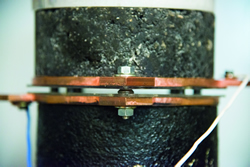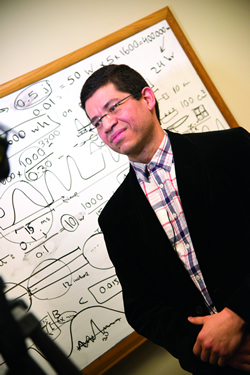
Harvesting Clean Energy from Traffic
UTSA engineers lead $1.32 million project for Texas Department of Transportation

One of the three prototypes that Dessouky and his team are developing to capture energy from traffi c. This particular device works by activating piezoelectric transducers to generate electric voltage that can be stored in capacitors at the side of the road. The piezoelectric device can harvest the energy, feed it to the power grid, or save it in roadside batteries and utilize it to charge electric cars, power roadside or traffi c lights. Furthermore, changes in the response of these piezoelectric sensors can be used as a means of monitoring the health of the pavement layers, where these sensors are installed.
Researchers at The University of Texas at San Antonio (UTSA) and the Texas A&M Transportation Institute (TTI) have been awarded a $1.32 million contract from the Texas Department of Transportation (TxDOT) as part of the jointly funded Federal Highway Administration’s state research program. Its premise is to design and develop a system to harvest energy created by the movement of vehicles along the state’s roadways and convert it into low-cost renewable electric power. The system also would allow TxDOT to continuously monitor the health of roadways to improve traveler safety.
Led by UTSA Associate Professor of Civil and Environmental Engineering Samer Dessouky, in conjunction with Lubinda Walubita at TTI, the research team will develop piezoelectric sensors that can be placed under asphalt layers. Those sensors will use the energy generated from moving vehicles to power roadside lights, traffic signals, billboards, charging stations for electric cars and roadway monitoring sensors.

Samer Dessouky
Piezoelectric materials are capable of generating electric power in response to the applied pressures from traffic loading. This technology has been field-tested already by a number of U.S. and international studies. It is attractive because it generates power without emitting greenhouse gases, as fossil fuel-generated power does. Furthermore, it requires no additional space as solar power does, since the power-generating modules are embedded into the road layers.
”This project could make Texas a leader in the use of piezoelectric technology to create ‘smart’ roads that not only generate clean power but also create a sustainable source of revenue for transportation infrastructure,“ said JoAnn Browning, dean of the UTSA College of Engineering. ”UTSA is committed to developing innovative solutions that impact society.“
The research team includes experts in pavement materials, multi-functional nanomaterials, sensor design and surface chemistry from UTSA, TTI and Southwest Research Institute (SwRI®).
The first phase of this project involves the design and development of the harvesting modules and will take 18 months. If the subsequent phases of this project get the go-ahead, the researchers anticipate having a complete, functional harvesting and sensing system ready for implementation within three and a half years. The systems would be installed permanently two inches below the pavement surface and would not interfere with the asphalt pavement milling and overlaying maintenance. Additionally, the system would be made from low-cost piezoelectric materials and sensors, and would not raise the cost of pavement maintenance operations.
– K.C. Gonzalez/Director of Communications and Special Projects

